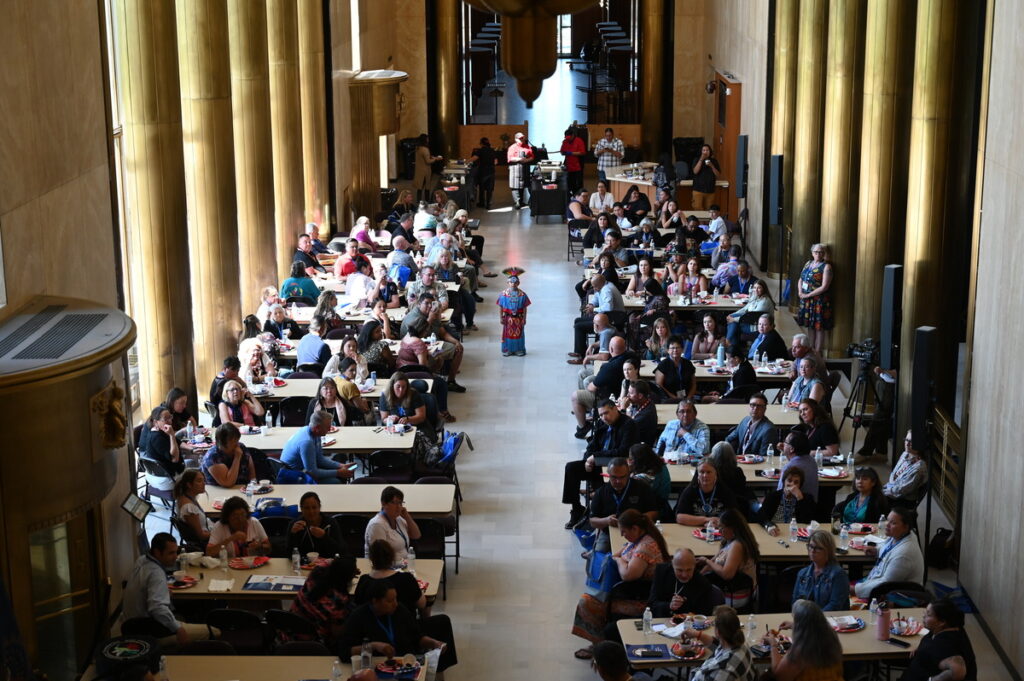
Berkley Chaske from Spirit Lake, now a seventh grader at Wachter Middle School in Bismarck, performed for a cultural presentation at the Indian Education Summit on July 6, 2023. (Photo courtesy of the Department of Public Instruction)
Marking a decade of educational innovation, the 10th annual Indian Education Summit will bring more than 200 educators to the North Dakota State Capitol from July 18-19.
When Lucy Fredericks joined the Department of Public Instruction as the director of Indian and Multicultural Education in 2012, she found that surrounding states such as Montana, South Dakota and Wyoming had conferences dedicated to Native education. As of 2022, there are more than 36,000 American Indians living in North Dakota, according to the U.S. Census Bureau, a figure that climbs to nearly 43,000 when including Natives who claim an additional race.
“I thought, well, how come North Dakota doesn’t have an Indian Education Summit? Also the fact that we’re the highest minority population in the state, it only made sense that we would provide some opportunities, professional development for teachers and educators about Native Americans that are living within North Dakota,” Fredericks said.

So she and Scott Davis, the executive director of the North Dakota Indian Affairs Commission at the time, decided to collaborate to create the Indian Education Summit.
The Department of Public Instruction and North Dakota Indian Affairs Commission co-sponsored the first annual North Dakota Indian Education Summit in 2014. The first summit was a one-day event, featuring a keynote speaker, some breakout sessions and a meal. Due to its initial success, they extended the conference into a two-day summit the following year. Now the summit has a committee of up to six people who plan the annual event. Every year the summit also includes cultural presentations by students and performances, such as the hoop dance.
The summit now has a keynote speaker for each day and consists of about 36 breakout sessions during the afternoons. Some of the sessions are repeated depending on the topic. The breakout sessions cover various aspects of Indian education that can aid teachers in the classroom.
Fredericks also believes the Indian Education Summit could be beneficial to educators who are working to implement Senate Bill 2304 into their curriculum. The 2021 bill requires all North Dakota schools to teach Native American history, culture and treaty rights, which only focuses on fourth- and eighth-grade students. “I think with Senate Bill 2304 being passed, this is really an opportunity to help educators meet that requirement,” Fredericks said.
Sessions this week include an analysis of the latest North Dakota Native American Needs Assessment Survey results, educational stability for at-risk students, and teaching youth how to tell their stories. Fredericks said some of the main goals of the workshops are to highlight culturally responsive practices and address Native students’ educational needs.
Sheeresa Begay, the district director of Williston Basin School District #7, will present her first summit session: “Leveraging AI in the Classroom.” During the July 19 workshop, Begay will introduce attendees to free and accessible teaching platforms. One of the programs she’ll demonstrate is Mindspark, developed by a nonprofit based in Colorado that focuses on educational systems.

The artificial intelligence tools Begay will share can assist teachers by helping them build a rubric, create a lesson plan, and work with individuals with specific learning disabilities, such as dyslexia and ADHD. Implementing this technology in classrooms will help remove some of the load from teachers’ plates so they can support students more effectively.
“I think as educators we have to jump into it because our kids, who are Gen Zers, already understand it, so they’re full-on integrated into it,” she said. “I wanted my session to be more integrative. When educators are coming to it, I want them to be able to practice utilizing AI in the session, and then be able to walk away with something tangible that they could use in their classroom.”
The Diné Nation citizen moved from New Mexico to North Dakota in 2016. She originally found out about the Indian Education Summit after conducting a Google search. At the time, she was doing research to find out what was happening in terms of Indian education across the state. Begay attended her first summit in 2022 when she went with her district to target school improvement.
“When I came out to the Indian Education Summit that first time, I wanted to be around other individuals who were in support of Indigenous education,” she said. “I found some people that I still talk to from the very first time that I came, and still connect with them because I feel like you can create partnerships and you can network with other individuals across the state.”
Fredericks is looking forward to meeting with the administrators, principals, counselors and teachers who will be attending the conference. “They’re all here to learn from each other — from the breakout sessions that we have and the keynote speakers and understanding Native American culture,” she said.
Educators such as Begay are excited to share their knowledge and continue to collaborate with others during the two-day conference. “I think what Lucy and her team put together is really profound,” Begay said.


